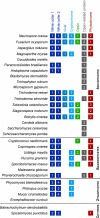A glimpse into the basis of vision in the kingdom Mycota
- PMID: 20451644
- PMCID: PMC2950209
- DOI: 10.1016/j.fgb.2010.04.009
A glimpse into the basis of vision in the kingdom Mycota
Abstract
Virtually all organisms exposed to light are capable of sensing this environmental signal. In recent years the photoreceptors that mediate the ability of fungi to "see" have been identified in diverse species, and increasingly characterized. The small sizes of fungal genomes and ease in genetic and molecular biology manipulations make this kingdom ideal amongst the eukaryotes for understanding photosensing. The most widespread and conserved photosensory protein in the fungi is White collar 1 (WC-1), a flavin-binding photoreceptor that functions with WC-2 as a transcription factor complex. Other photosensory proteins in fungi include opsins, phytochromes and cryptochromes whose roles in fungal photobiology are not fully resolved and their distribution in the fungi requires further taxon sampling. Additional unknown photoreceptors await discovery. This review discusses the effects of light on fungi and the evolutionary processes that may have shaped the ability of species to sense and respond to this signal.
Copyright © 2010 Elsevier Inc. All rights reserved.
Figures



References
-
- Alves SB, Forti LC, Cividanes FJ. Influence of light color on some biological activities Metarhizium anisopliae (Metsch) Sorok. an entomopathogenic fungus. Rev. Bras. Ent. 1980;24:123–125.
-
- Ambra R, Grimaldi B, Zamboni S, Filetici P, Macino G, Ballario P. Photomorphogenesis in the hypogeous fungus Tuber borchii: isolation and characterization of Tbwc-1, the homologue of the blue-light photoreceptor of Neurospora crassa. Fungal Genet. Biol. 2004;41:688–697. - PubMed
-
- Andrieu S, Biguet J, Jaques R, Dehorter B, Lacoste L. Photoinhibition de la Chlamydosporulation de Candida albicans. Sabouraudia. 1977;15:207–214. - PubMed
-
- Backus MP. Phototropic response of perithecial necks in Neurospora. Mycologia. 1937;29:383–386.
Publication types
MeSH terms
Substances
Grants and funding
LinkOut - more resources
Full Text Sources
Medical

